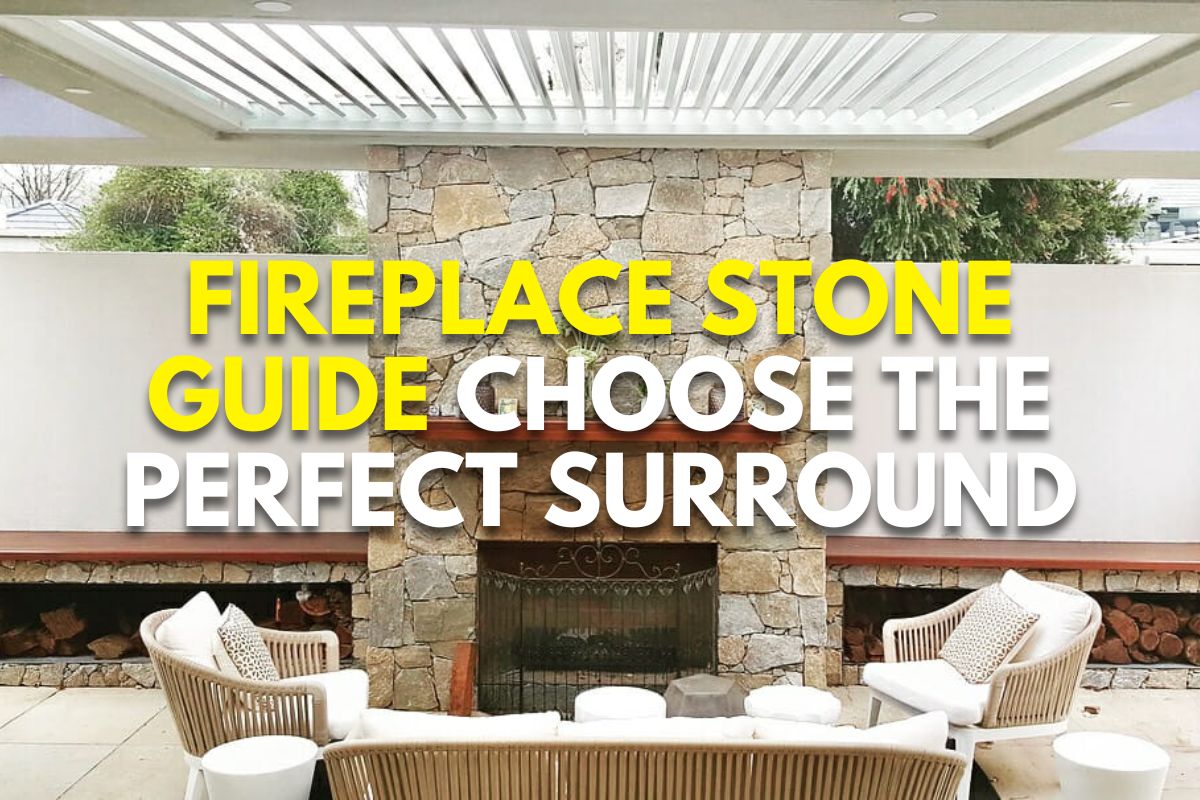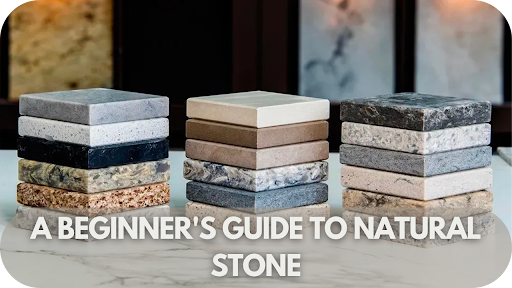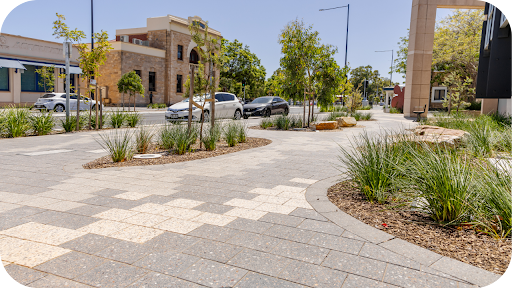
Dreaming of a fireplace that complements your home’s style?
But overwhelmed by the countless stone surround options?
Our guide unveils the perfect stone to elevate your fireplace and design!
Factors to Consider When Choosing Fireplace Stone
Absolutely! Here’s a breakdown of the factors to consider when choosing fireplace stone:
- Style: Your stone choice should reflect your room’s overall design aesthetic. Rustic spaces call for natural textures like limestone or stacked stone, while sleek, modern rooms shine with polished granite or quartzite.
- Heat Resistance: Opt for heat-resistant stones like granite, soapstone, or limestone. Avoid porous stones that can crack or stain under direct heat.
- Maintenance: Some stones require regular sealing (like marble), while others require low maintenance (like granite). Factor in your willingness to upkeep the stone when making a decision.
- Budget: Stone costs vary significantly. Marble tends to be pricier, while limestone or fieldstone can be more affordable. Determine your budget before falling in love with a particular stone.
- Professional Consultation: If you’re unsure about stone types, suitability, and installation needs, it’s always wise to consult with a fireplace or stone expert.
- Climate: If you have an outdoor fireplace, choose a stone that can withstand your local climate’s extremes (freeze-thaw cycles, intense sun exposure, etc.).
- Usage: Will your fireplace be a primary heat source or more decorative? This can influence heat resistance requirements and your focus on aesthetics.
- Surrounding Materials: Consider how the stone interacts with your hearth, mantel, and walls. Choose a stone that complements or creates a pleasing contrast with the existing elements.
- Colour Variation: Many natural stones have significant colour variations within a batch. Understand the range of tones within a stone type, and ensure you’ll be happy with the look before ordering.
- Eco-Friendliness: If sourcing sustainable materials is essential, research the quarries and suppliers for your chosen stone. Some offer more environmentally conscious options.
Popular Fireplace Stone Options
Absolutely! Here’s a breakdown of popular fireplace stone options:
- Marble: This classic choice exudes elegance and luxury. Its smooth surface and intricate veining create a timeless aesthetic. Marble is heat-resistant but requires sealing to prevent stains.
- Granite: Exceptionally durable and versatile, granite comes in a wide array of colours and patterns. It’s also highly heat-resistant and low-maintenance, making it a practical and beautiful choice.
- Limestone: This softer stone brings a natural, earthy warmth to fireplaces. Its subtle colours and textures work beautifully in both rustic and traditional settings. Limestone is heat-resistant but does require sealing for protection.
- Travertine: With its unique pitted texture and warm tones, travertine adds a touch of rustic charm. It’s moderately heat-resistant but requires careful sealing due to its porous nature.
- Slate: A rugged, natural-looking option, slate offers excellent durability and heat resistance. Its rich colours and textured surface create a dramatic and timeless look.
- Quartz: This engineered stone offers a sleek, contemporary look. Quartz is a durable and low-maintenance choice, boasting excellent heat resistance and minimal upkeep requirements.
- Climate: If you have an outdoor fireplace, choose a stone that can withstand your local climate’s extremes (freeze-thaw cycles, intense sun exposure, etc.).
- Usage: Will your fireplace be a primary heat source or more decorative? This can influence heat resistance requirements and your focus on aesthetics.
- Surrounding Materials: Consider how the stone interacts with your hearth, mantel, and walls. Choose a stone that complements or creates a pleasing contrast with the existing elements.
- Colour Variation: Many natural stones have significant colour variations within a batch. Understand the range of tones within a stone type, and ensure you’ll be happy with the look before ordering.
- Eco-Friendliness: If sourcing sustainable materials is important, research the quarries and suppliers for your chosen stone. Some offer more environmentally conscious options.
Matching Fireplace Stone to Interior Styles
Absolutely! Here’s a look at matching fireplace stone to interior styles:
- Traditional Style: Classic and elegant, traditional designs pair beautifully with marble (think grand mantels), polished granite, or subtly textured limestone. These stones enhance the timeless feel and add a touch of luxury.
- Modern Style: Sleek and minimalist, modern spaces call for smooth quartz, honed granite, or dramatic slate. Consider linear designs and contrasting finishes for a contemporary feel. Textured travertine can add subtle warmth if desired.
- Rustic Style: For a cosy, farmhouse feel, stacked stone, fieldstone, or limestone work perfectly. Their natural textures and earthy tones bring warmth and create a focal point that exudes rustic charm.
- Coastal/Beachy: Opt for light-coloured limestone, textured sandstone, or smooth river rocks. These evoke the natural elements of the seashore and bring a relaxed, airy vibe to your space.
- Mid-Century Modern: Look for clean lines and geometric shapes. Smooth concrete, terrazzo, or even a bold, retro-colored quartz can perfectly capture the playful sophistication of this style.
- Industrial: Exposed brick, rough-cut slate, or even weathered concrete add to the raw, urban feel of industrial spaces. Pair these with metal accents and clean lines for a cohesive look.
- Transitional: Mixing traditional and modern elements, the transitional style allows for various stone options. For a balanced look, consider a classic limestone mantel with a sleek granite hearth, or try a textured quartz surround in a neutral tone.
- Bohemian: Express your eclectic style with colourful tiles, mismatched stone pieces, or bold, patterned marble. Don’t be afraid to experiment with textures and unexpected combinations.
Remember: Your stone choice is key to the overall fireplace design. Consider the hearth, mantel, and surrounding materials for a cohesive and stylish look that reflects your home’s aesthetic.
Installation Tips and Considerations
- Hire a Professional: Installing a fireplace surround requires careful planning, building code knowledge, and masonry techniques. Hire a qualified fireplace mason or stone specialist for the safest and most beautiful results.
- Weight Considerations: Stone surrounds can be heavy. Ensure your existing structure can handle the additional weight, especially when installed on an upper floor. A professional can assess this for you.
- Fire Safety: Installing heat-resistant materials around the firebox is crucial. Your installer should be well-versed in proper clearances and fireproofing techniques.
- Surface Preparation: The wall where the surround will be installed must be flat, smooth, and structurally sound to ensure proper stone adherence.
- Mortar and Grout: Choose mortar and grout specifically designed for your stone type and heat exposure level. Your installer will guide you towards the most suitable options.
- Layout and Planning: Before beginning installation, carefully plan the stone layout. This involves measuring, marking for cuts, and dry-fitting your stones. Ensure your desired pattern and design work well with the dimensions of your fireplace and the room.
- Waterproofing: Behind the surround, especially if dealing with exterior walls or chimneys, a waterproof membrane may be necessary to prevent moisture damage. Your installer can advise on best practices for your specific situation.
- Level and Plumb: Use a level and plumb line throughout the installation to ensure your stones are perfectly aligned horizontally and vertically. An uneven surround will be immediately noticeable.
- Sealing (If Necessary): If using a porous stone, apply a high-quality sealer after installation and according to the manufacturer’s instructions. This will protect the stone from stains and heat-related damage.
- Curing Time: Allow the mortar and grout to cure fully before using your fireplace. Refer to the product instructions for specific drying times.
Remember: Even if you plan to DIY your fireplace surround, it’s recommended that you consult a professional for advice on the suitability of your chosen stone and any structural considerations and to ensure your project meets safety codes.
Conclusion
Your fireplace deserves a surround that reflects your style, stands up to use, and fits your lifestyle.
Now that you have this knowledge, it’s time to find the perfect stone to transform your fireplace into a stunning centrepiece!
More To Explore

A Beginner’s Guide to Natural Stone: Everything You Need to Know Before You Buy
Natural stone brings unmatched beauty and durability to any space, but choosing a suitable material can be overwhelming. From the elegance of marble to the

Streetscapes With Soul: How Cities Across Australia Build in Stone
Streets are more than pathways. They carry the character of communities, reflecting culture, heritage, and the way people connect. At the heart of these spaces


